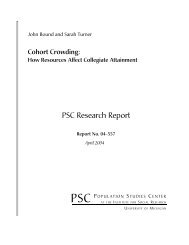Tracking metropolitan America into the 21st century - Population ...
Tracking metropolitan America into the 21st century - Population ...
Tracking metropolitan America into the 21st century - Population ...
You also want an ePaper? Increase the reach of your titles
YUMPU automatically turns print PDFs into web optimized ePapers that Google loves.
Popular UsageThe new system may, at least over <strong>the</strong>long run, exert as much influence onour popular understanding of <strong>metropolitan</strong>areas as on our researchunderstanding. Popular notions of<strong>metropolitan</strong> areas are shaped not onlyby what geographies <strong>the</strong>y contain, butalso by name recognition. Both maycontribute to <strong>the</strong> economic and socialidentity of local residents, businesses,and governments.With respect to <strong>the</strong>ir geographicmakeup, it is not surprising that <strong>the</strong>new <strong>metropolitan</strong> definitions are still“off <strong>the</strong> radar” in large swaths of <strong>metropolitan</strong><strong>America</strong>, given that <strong>the</strong> policyand research communities have yetto completely embrace <strong>the</strong> changes. Inpart, this is because institutions likeregional media and chambers of commercemediate between what <strong>the</strong> federalgovernment decides is a<strong>metropolitan</strong> area, and what averagecitizens consider to be <strong>the</strong>ir region.Newspaper “Metro” sections, forinstance, typically report on jurisdictionsin which <strong>the</strong>y have a substantialsubscriber base. Thus, news in TheWashington Post covers roughly 14counties, ra<strong>the</strong>r than <strong>the</strong> 18 that makeup <strong>the</strong> Washington-Arlington-Alexandria,DC-MD-VA-WV Metro SA. TheMid-<strong>America</strong> Regional Council, <strong>the</strong><strong>metropolitan</strong> planning organization forgreater Kansas City, is composed ofeight counties, while <strong>the</strong> new KansasCity, MO-KS Metropolitan StatisticalArea contains 15 counties.At <strong>the</strong> same time, several of <strong>the</strong>metro areas that underwent significantchanges might find more local receptivitythan <strong>the</strong>ir older versions. The oldNew York PMSA, consisting of <strong>the</strong> fivecity boroughs and three upstate NYcounties, bore little relation to <strong>the</strong>average citizen’s conception of <strong>the</strong>metro area. The revised New YorkMetro SA, which captures suburbanLong Island and much of nor<strong>the</strong>rnNew Jersey, probably comes muchcloser. Similarly, <strong>the</strong> Los Angelesmetro area, which before includedonly Los Angeles County, now takes inOrange County as well, better reflecting<strong>the</strong> economic ties between <strong>the</strong>setwo jurisdictions.Names, however, seem to carry evenmore weight than geographic compositionin <strong>the</strong> public eye. The status ofsuburban places like Sandy Springs,GA (Atlanta), Sugar Land, TX (Houston),Edison, NJ (New York), andNaperville, IL (Chicago) was thusimmediately elevated when <strong>the</strong>y eachfound a spot in <strong>the</strong>ir respective metroarea’s name. 34 While some of thoseplaces might earn greater acceptanceas a result—Sandy Springs is currentlyin a pitched battle to incorporate as acity—o<strong>the</strong>rs caused confusion and dismay.Consultations with local officialsresulted in OMB changing <strong>the</strong> NewYork-Newark-Edison, NY-NJ-PA MetroSAto <strong>the</strong> New York-Nor<strong>the</strong>rn NewJersey-Long Island, NY-NJ-PA MetroSAin December 2003. Public opinionsimultaneously dislodgedCheektowaga and Tonawanda, NY,both principal cities in <strong>the</strong> Buffalometro area, from that area’s name infavor of <strong>the</strong> fourth-largest principalcity, Niagara Falls, which is both atourist destination and source ofregional identity.Of course, <strong>the</strong> power of a name iseven more evident in micropolitanareas, and new <strong>metropolitan</strong> areas.Hundreds of smaller counties andtowns formerly part of “rural <strong>America</strong>”suddenly acquired <strong>the</strong>ir own identity,and increased attention fromresearchers and businesses. 35 Evencounties that formerly resided at <strong>the</strong>fringe of large <strong>metropolitan</strong> areas, likeAshtabula, OH (formerly in <strong>the</strong> Clevelandmetro area) and Nye, NV (formerlyin <strong>the</strong> Las Vegas metro area),may gain more stature from a micropolitanlabel than <strong>the</strong>y lost in separatingfrom a <strong>metropolitan</strong> center.These examples of definitionalchanges demonstrate that federal statisticalpolicy can impact how we liveand work. In <strong>the</strong> end, both researchand policy have an important role toplay in bridging <strong>the</strong> gap between <strong>the</strong>statistical versions of <strong>metropolitan</strong>areas and <strong>the</strong> popular notions of <strong>the</strong>regions in which <strong>metropolitan</strong> residentslive. To <strong>the</strong> extent that researchcan narrow this gap over time, <strong>metropolitan</strong>-levelresearch will providegreater insights for government andbusiness decisions. OMB’s new <strong>metropolitan</strong>classification system thus presentsboth a unique challenge and afresh opportunity for <strong>metropolitan</strong>research to make a real-world impact.November 2004 • The Brookings Institution The Living Cities Census Series 21















